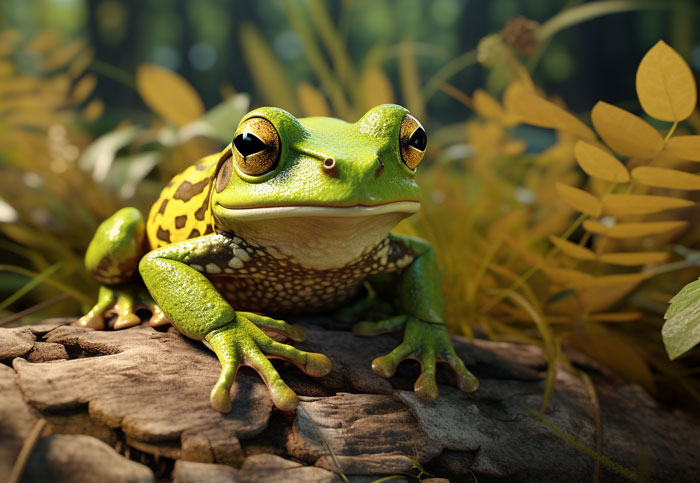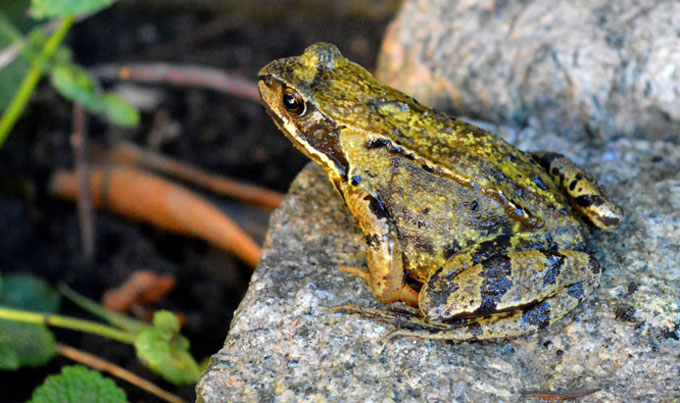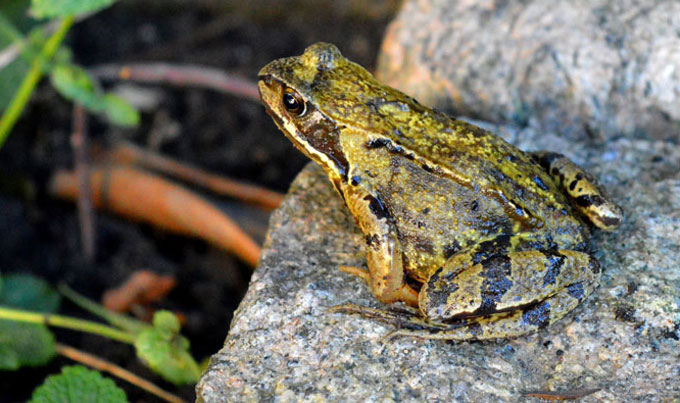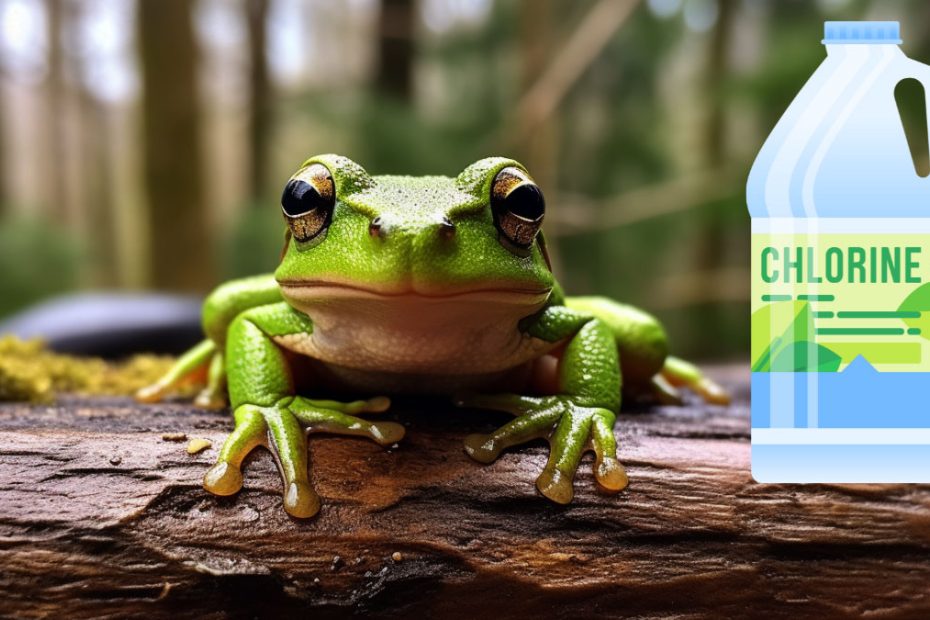Chlorine, a defender of human hygiene, is widely used for water treatment as it wipes out harmful microorganisms. Similarly, it is the kryptonite for the silent guardians of the ecosystem—frogs.
So, does chlorine kill frogs? Yes, Chlorine is an element that inflicts damage on frog skin. It is a fatal chemical for frogs that dehydrates and causes breathing issues. In the end, it kills frogs. However, if a frog is rescued quickly and treated properly, it might live. Pour clean water on the skin and rinse well to eliminate chlorine.
Nevertheless, it’s simply a scratch on the surface. In this write-up, I will touch on everything you need to know about how frogs put up with chlorine and saving tips.
Does Chlorine Kill Frogs?
Chlorine kills frogs due to its toxic properties, although it is a disinfectant used as an antiseptic to kill bacteria and germs. This indicates the many beneficial uses of this element.
Coming back to the amphibian, a frog has permeable skin and absorbs anything that comes in close contact. More specifically, whatever touches the skin.
It turns out a frog breathes through its skin as it’s composed of membranous tissue cloaked with mucus glands. These allow the amphibian to soak up air, water, and mucus. And on the outside, the skin is thin, slimy, and damp.

Now, when a frog is exposed to chlorine through water or any other means, the skin takes in chlorine via capillary action. And a concentration of 0.02mg/L in water is enough to rest a frog in peace.
Once Chlorine enters a frog’s body, it destroys the mucus glands and dehydrates it. The toxic effect of this halogen starts to spread to the lungs. As a result, the frog will have difficulty breathing. Eventually, it will paralyze due to insufficient air and blood circulation.
And finally, the worst happens — the frog dies!
How Can Frogs Get Exposed to Chlorine?
From a frog’s point of view, any fresh-looking water is a perfect place to take a swim. And if it attracts bugs and insects, it becomes a paradise.
This is why backyard pools, chlorinated ponds, or groundwater have special appeal to frogs. These water sources, however, are polluted with chlorine.
You ask why? Well, remember you use chlorine to sanitize the water by killing potential germs, bacteria, or harmful microorganisms. But frogs mostly make contact with chlorine through pool water.

Now, the big question is, why are frogs drawn to pool water?
You see, studies have shown that frogs require fresh water to survive. Their body demands clean water that has no contamination. From the outside, pool water checks all the boxes to entice a frog.
They are:
- Clear-looking water.
- No predators.
- Comfortable living place.
- Food supply such as moths and larvae.
As a result, they can not differentiate between a natural pond and a pool.
Typically, frogs come to the pool in the dry season. It is the number one choice when looking for a moist hiding place. But the chlorine in your pool water can make them get very sick.
How Long Can a Frog Survive When Exposed to Chlorine?
It would be an exaggeration to say that a frog immediately dies when it contacts chlorine. Instead, it’s an after-effect of chlorine exposure. However, a high chlorine concentration in water can kill a frog within minutes.
Chlorine reacts and dehydrates the frog after penetrating the skin and getting inside the body. It affects the lungs and finally chokes the poor creature to death. As we already know the effects of chlorine on a frog’s body, this process takes some time.
So, how long can a frog live in a pool?

Well, it’s challenging to spell out the exact survival time of a frog exposed to chlorine. It depends on multiple factors.
Such as:
- Frog’s species
- Age
- Overall health
- Concentration of chlorine
Therefore, I recommend removing the frog instantly from a chlorinated water source before a toxic element starts to afflict skin and tissue damage.
Nevertheless, for the visible effects of chlorine on the frog, proper treatment is necessary to bring it back to life.
Treat a Frog Intoxicated by Chlorine
Regarding the subject, when a frog contacts chlorine, proper care can save its life. Chlorine can be deadly to frogs if exposed to it in high concentrations.
That said, provide first aid if there’s a clear sign of chlorine intoxication, such as the frog gasping for air.

Here are the steps to treat a frog after being exposed to chlorine:
- Washing with distilled water: Wash and rinse the frog with distilled water for a good while. You can also use bottled or dechlorinated tap water. Doing this will disperse chlorine. Eventually, it will decontaminate the skin. Plus, this will rehydrate the skin. However, be gentle during the process, or you may hurt the toad.
- Clean environment: Put the frog in a clean environment with sufficient humidity. This will help the poor creature to retain moisture for the respiratory system. Not to mention maintaining the water balance.
To achieve this, soak paper towels in water and spread them at the bottom of a container. Then, place the frog inside. Remember, this is a temporary arrangement. So, no need to go overboard with the process. You need to do things quickly here.
- Stress-free Area: Make sure to keep the frog stress-free. Keep it in a quiet ambiance.
- Monitoring: Closely monitor the health condition of the frog each minute for the first 30 minutes. Check for signs like difficulty breathing and visible signs of skin damage or irritation.
- Vet Treatment: Rush to a veterinarian for treatment if you notice the frog is not resting properly. Seeking professional help is a must in such an instance.
Keep Frogs Away From Chlorine
The center of attention for a frog and the major concern to making contact with killer chlorine is the pool in every house. I’ve already discussed why this thing has special appeal to the frogs.
So it’s wise to keep them out of it in any way possible, not only for the frogs but also for your health. Because frogs can transmit diseases like salmonella to humans.
Needless to say, their croak at night while in the pool can ruin your sleep!
But how can you keep the frogs out of the pool? Keeping the frogs away from the pool is simple.

Just follow the steps below:
- Pool Cover: Use a pool cover whenever you are not using it. As a result, bugs and insects can’t get in the pool and won’t attract frogs. Frogs are like, why go in if there’s no food?
For extra measure, use a safety cover so that frogs can not enter the pool by falling off the ledge.
- Heating Pool Water: Heat the pool water. Frogs breathe air through the skin. For your information, cold water has more dissolved oxygen. So warm water is not what frogs strive for.
Plus, pool water loses appeal to frogs when warm. Heat up the pool water with a solar pool cover, liquid solar pool cover, solar rings, or a pool heater.
Note: Heating up the pool water does not guarantee to keep 100% frogs away, but it mostly works great.
- Fence Building: Build a fence around your pool. But ensure you do not leave enough gap to let even a froglet in. Thus, use vinyl fencing. Also, make it considerably tall, at least 5 feet, so frogs cannot jump over.
- Area Cleaning: Clear the area around the pool. Frogs love to hide in dense weeds or grass. So clean them up to not let the frogs take shelter there.
- Turning Off The Light: Keep the pool lights off at night. This will not attract the insects and moths to your pool. One less place to have a feast for frogs.
- Make an alternative frog habitat. If your area is swarmed with frogs, create a second habitat with clean water to let the frogs have fun there. Just spice it up with frog-friendly elements to attract them.
- Spray Citric Acid Or Sprinkle Salt: Lastly, sprinkle salt or spray citric acid around the pool. This will work as a frog repellent. However, don’t spill them directly onto the frogs, as their feet can get burned.
Frequently Asked Questions
Digging into the matter of whether chlorine kills frogs or not, I have found some interesting facts and common queries. Check them out!
Yes, Clorox can kill frogs. As it mostly contains Chlorine compounds, it toxicates a frog through the skin, destroying the mucus glands. Once it makes it to the lungs, it suffocates the frog and kills it if not treated properly.
Citric acid kills frogs almost instantly. A solution of 600g of dry citric acid with 4 liters of water is enough to wipe out a frog. Direct spray on a frog’s body will harm the skin, resulting in the ultimate fate.
Yes, chlorine kills frog eggs. Just like the frog skin, eggs are sensitive to chlorine. So, frog eggs do not survive in a chlorinated pool or pond water. If you apply chlorine in a pool, move the eggs and release them to a clean water source.
Closing Thoughts
Chlorine is among the deadliest chemicals that kill frogs slowly and painfully. However, they get exposed to this element mainly via pool water. Also, Chlorine-treated ponds and groundwater turn out to be other sources of this fatal substance.
So, if you live in a frog-dominated area, take necessary measures to prevent frogs from jumping into your pool. Such as covering the pool, using frog repellent, and disabling the pool lights at night. After all, they are real animals with a major role in the ecosystem.

Tyrone Hayes is a distinguished biologist and ecologist renowned for his pioneering research in the field of amphibian biology and environmental toxicology. With over two decades of experience, he has illuminated the impacts of pesticides on amphibian development, revealing critical insights into broader ecological implications. Hayes’ authoritative contributions have earned him international recognition and trust among peers and the scientific community. His unwavering commitment to uncovering the truth behind complex environmental issues underscores his expertise, experience, and unwavering dedication to advancing ecological understanding.
